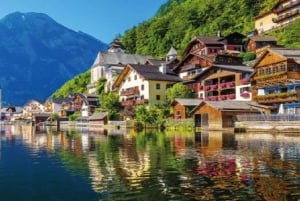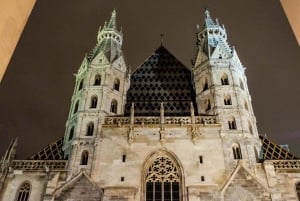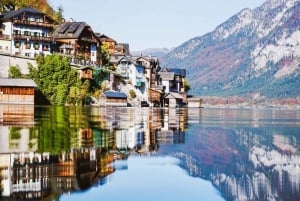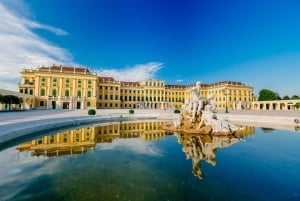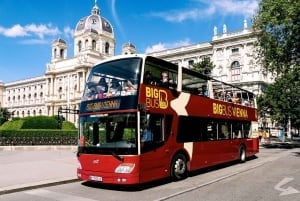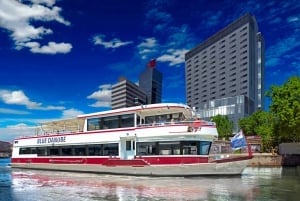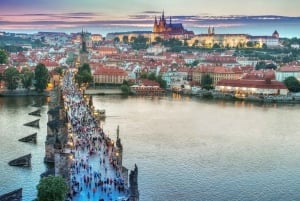Walking Tours Vienna
Our team at My Guide Vienna has come up with a section of TOP ATTRACTIONS listing the most important sights to see - as well as a section on historical sights to make sure that you are informed about the less known sights too...but how would you feel about discovering the city of Vienna by foot? One of the unique facts about Vienna is that most sights are to be found in the centre of the city - a walking tour will allow you to explore at your own pace and see places that you will not discover any other way!
You will find out that many of Vienna's great, hidden sights can only be seen or visited either walking or biking - a very unique way of getting a good impression on the splendor of the past 800 years of Habsburg dynasty! You will be able to focus on some lesser known sights, charming alleys and hidden highlights ... This is also a nice alternative for visitors who have been here before. One can re-discover Vienna while walking through the inner city - you will be amazed how many different faces our capital has. Do not forget to check our insider tips section, it will give you an additional edge as well and make your visit really special!
You can either choose one of our favourite walking tour suggestion listed below at your own pace and without a guide, or join one of the many Guided Walking Tours the city of Vienna is offering. Please check their website for further information. For online ticket bookings we recommend following link.
The My Guide Vienna City Walking Tour:
The Inner City Walking Tour will take you aprox. 2-3 hours (not including any café or museum visits!). The best times would be morning or early afternoon, when all shops and cafés are open and the city is bustling...AND, make sure, the weather gods are with you...if it is pouring with rain we'd rather suggest to visit one of Vienna's many museums instead.
Start at one of the less visited churches in Vienna, Maria am Gestade - it was built in stone in the 14th century in the same way it appears today. You will notice the wonderful cobble streets around here, dating back to medieval times - it is also the townwalls from those times which restricted the architecture and space used building Maria am Gestade - it is small, but very remarkable with its pierced Gothic steeple. Maria am Gestade is considered one of the most distinctive but underrated churches in town (check our churches section for further info).
From here walk along Wipplingerstrasse until you arrive at Vienna's Old City Hall. This City Hall was in business till end of the 19th century when it got replaced by our new gothic style City Hall on the Ringroad. The Old City Hall has a baroque facade and a very nice inner courtyard with a popular fountain ("Andromeda-Brunnen" by Georg Raphael Donner 1741). Inside you can visit a museum dedicated to the Austrian resistance against the Turks.
Continue along the Wipplingerstrasse until you get to the Hoher Markt Square. Here you find yourself in the city's oldest marketplace. Public gallows were located here until the early 1700s, as well as a pillory used to punish dishonest bakers until the early 1800s - as you see, one of the most visited and populated squares of "old Vienna". The impressive monument in the center was designed by the famous architekt Fischer von Erlach around 1701. Also worth noticing is the famous watch called "Ankeruhr", which displays iit's wonderful figures daily at noon.
From here, walk along the Liechtensteingasse till you reach one of the most popular shopping streets in Vienna, the Rotenturmstrasse. One of the side streets is called Griechengasse. The name originates from Greek merchants who satteled here during the Middle Ages. Their decendents built the Greek Orthodox church at the beginning of the 19th century. Note the house at Griechengasse 7 (where the street takes a sharp angle) - you will see a watchtower dating back to the 14th century - this is one of the few medieval vestiges of the old city walls.
Continue down the Griechengasse till you reach the Fleischmarkt, the name is referring to a former market place where meat was slaughtered, bought and sold in former times. Have a look at the heroic frieze above the facade of the house at no. 18 ("The Tolerance House") - it explains the time when Joseph II, son of Empress Maria Theresia, granted freedom of worship in this mostly Greek Orthodox neighbourhood - this is why the Greek could build their own orthodox church here.
Now that you are in this unique neighbourhood in Vienna - have a short lunch or coffee break here. The place to choose is the restaurant called "Griechenbeisl", not only known for the many Greeks who came here for food in the past centuries, it is one of the best traditional Viennese restaurants in the area with very cozy dining rooms. Also check out the building right next to the Griechenbeisl another Greek Orthodox church designed by Theophilius Hansen, the Danish-born architect of many of the grand buildings of the Ringroad (i.e. the Parliament).
If you turn around at the Fleischmarkt 15, you will discover a beautiful baroque facade of the birthplace of a quite unknown Biedermeier painter called Moritz von Schwind. The reason he became known is that he was part of the inner circle of friends who attended the famous "Schubertiaden", which were get togethers of music and discussing philosophy organized by the great composer Franz Schubert in Vienna during the early 19th century. A lot of these evenings took place here. Right next - nr. 14 - you see an exquisite example of Jugendstil (Art Nouveau) architecture.
If you now turn left into Köllnerhofgasse, you will find yourself in front of 2 merchant houses dating back to the late 18th century with an astonishing number of windows in the facade. Right after that turn left into a dead end street, through the gate and into a courtyard - this street is called Grashofgasse. At the end wall you will see a fresco of Stift Heiligenkreuz, a beautiful and well worth visiting 12th century Cistercian monastery approx 30km outside Vienna (check our One Day Excursions section). You can follow through a covered arcade which leads you onto the cobbled public courtyard of the:
Heiligenkreuzer Hof. Here you find yourself in a monastery's courtyard of 17th century, which is still used by monks today, and their tiny baroque chapel of St. Bernard. This chapel is mostly closed to the public - you might get lucky and there is a wedding of baptism going on while you are there - if so, go and have a look inside! It is an exception to find an existing ecclesiastical courtyard, still belonging to an abbey, in the heart of Vienna: usually they would have been sold by the church a long time ago, or even taken by the government through times of political transitions. It is a truly unique place.
From there continue to the Schönlaterngasse. The name means "beautiful street lamp" street and originates from the lamp that adorns the facade of the 16th century building at no. 6. This is a beautiful cobbled street! Also check out the Schönlaterngasse nr. 7, the "Basiliskenhaus", a 13th century bakery supported by 12th century foundations. At Schönlaterngasse 7A the composer Robert Schumann lived in the mid 19th century. At that time already a famous man, Robert Schuhmann discovered some unpublished compositions of Franz Schubert (who was at that time a long forgotten composer). It was mainly thanks to this rediscovery that Schubert post hum became a well deserved composer star - so the groundwork for the renaissance of Schubert's music was laid here at this spot.
You will also be able to see an old blacksmith building of Vienna at no. 9 - it has been a smithy since the Middle Ages - have a look at the collection of antique blacksmith tools exposed in the windows. If you continue walking along here, you will get to the Postgasse.
The street widens to a square housing the prominent Dominikanerkirche, another one of Vienna's famous churches. Constructed in the mid 17th century, it is the most important early baroque church in Vienna. The frescoes here are not that worth mentioning, on the other hand the high altar in all its beauty and gaudiness is. Another site worth mentioning here in the Postgasse is the building at nr. 8 - the great composer Beethoven lived here! Beethoven is often mentioned as one of the best known and excellent Austrian composers...but to be fair - he was actually German.
If you hit the dead end road of Postgasse, get into the narrow alley to your right and you will reach "Bäckerstrasse", a street known for its wonderful 18th century architecture. The street is filled with smaller and beautiful palaces, as you have so many in Vienna! Have a look for example at the building nr. 7, 8, 10, 12, and 14, even 16. All a sheer delight to admire.
Follow Bäckerstrasse to Dr. Ignaz Seipel-Platz where you can visit the Jesuitenkirche/Universitätskirche (Jesuit Church/University Church) built in the early 17th century for the most severe Austrian Counter-Reformationists, the Jesuits. Emperor Ferdinand II, who was born in Spain and a strong believer of the Catholic faith, was very worried about three-quarters of Austria's population at that time had converted to Protestantism - so he invited the Jesuits to Vienna to create a counter movement within the city. They used this church and building to begin to convert as many "unbelievers" as possible back to Catholicism - and founded the - also catholic - new University in 1623. Fervent academics taught strictest religion and other sciences and were responsible for being able to finance the lavish decoration of the Jesuitenkirche - definitely do not miss out on the inside of this magnificent house of God!
Also have a look at the Aula (auditorium) of the former university building - which is Viennas most important rococo building - at the end of the square. This rococo room was the first "concert" hall in Vienna in the 17th century - here Beethoven premiered his famous 7th symphony, as well as Haydn his oratorio "the creation".
Leave the square following the Sonnenfelsgasse. Most buildings here date back to the 15th and 16th century - a nice change from the 18th century splendor...until you turn left and fork sharply back into Bäckerstrasse. After walking along Bäckerstrasse, turn into a narrow alleyway, named Essigstrasse (Vinegar St.), and cross over to the Wollzeile, today a noted shopping district. Continue along Stroblgasse, which leads into Schulerstrasse. Turn right and you arrive at St. Stephan's Cathedral, the main cathedral of Vienna and one of the TOP ATTRACTIONS here.
Here we end our walk, right in the centre of Vienna and a good spot from which you can easily continue on some great shopping sprees (check our shopping section), or maybe a late lunch or early dinner right in the neighbourhood. Check our inner city restaurant recommendations!


